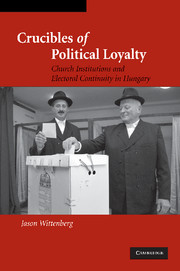Book contents
- Frontmatter
- Contents
- List of Figures
- List of Tables
- Acknowledgments
- INTRODUCTION
- 1 EXPLAINING POLITICAL PERSISTENCE
- 2 ELECTORAL PERSISTENCE AND VOLATILITY IN HUNGARY
- 3 THE CHURCHES FIRST CONFRONT COMMUNISM
- 4 THE BATTLE FOR SOULS, 1948–1956
- 5 THE BATTLE FOR SOULS AFTER 1956
- 6 CHURCH COMMUNITY AND RIGHTIST PERSISTENCE: STATISTICAL EVIDENCE
- 7 CONCLUSION
- Appendices
- Bibliography
- Index
- Titles in the series
5 - THE BATTLE FOR SOULS AFTER 1956
Published online by Cambridge University Press: 02 September 2009
- Frontmatter
- Contents
- List of Figures
- List of Tables
- Acknowledgments
- INTRODUCTION
- 1 EXPLAINING POLITICAL PERSISTENCE
- 2 ELECTORAL PERSISTENCE AND VOLATILITY IN HUNGARY
- 3 THE CHURCHES FIRST CONFRONT COMMUNISM
- 4 THE BATTLE FOR SOULS, 1948–1956
- 5 THE BATTLE FOR SOULS AFTER 1956
- 6 CHURCH COMMUNITY AND RIGHTIST PERSISTENCE: STATISTICAL EVIDENCE
- 7 CONCLUSION
- Appendices
- Bibliography
- Index
- Titles in the series
Summary
Introduction
János Kádár arrived in Budapest with the Soviets on November 7, 1956. Though nominally head of a “new Hungarian revolutionary worker-peasant government,” he initially enjoyed little real authority. The army had sided with the revolution, requiring the establishment of a “Hungarian revolutionary home guard militia” composed of loyal communists. The Hungarian Workers Party (MDP) had dissolved, reemerging as the Hungarian Socialist Workers Party (MSZMP). The new party declared its adherence to the same principles as its predecessor, but explicitly distanced itself from both the “left-wing” errors of the Rákosi era and the “right-wing” deviation represented by Imre Nagy. However, in December 1956 the newly christened party could boast only 37,000 members, as against several hundred thousand before the revolution.
Although formal armed resistance to the Soviet army had ended by the second week of November, it cannot be said that resistance per se ceased, or that victory could be declared. Cardinal Mindszenty took refuge in the U.S. embassy; Imre Nagy escaped to the Yugoslav. In late November, some intellectuals and students demanded a Soviet withdrawal, the return of Nagy, and the establishment of representative democratic socialism. A general strike was called and a women's demonstration organized for early December. Later that month, the State Office for Church Affairs (ÁEH) was abolished and its functions subsumed under the Ministry of Education.
Yet the Party moved quickly to assert its authority.
- Type
- Chapter
- Information
- Crucibles of Political LoyaltyChurch Institutions and Electoral Continuity in Hungary, pp. 152 - 200Publisher: Cambridge University PressPrint publication year: 2006



